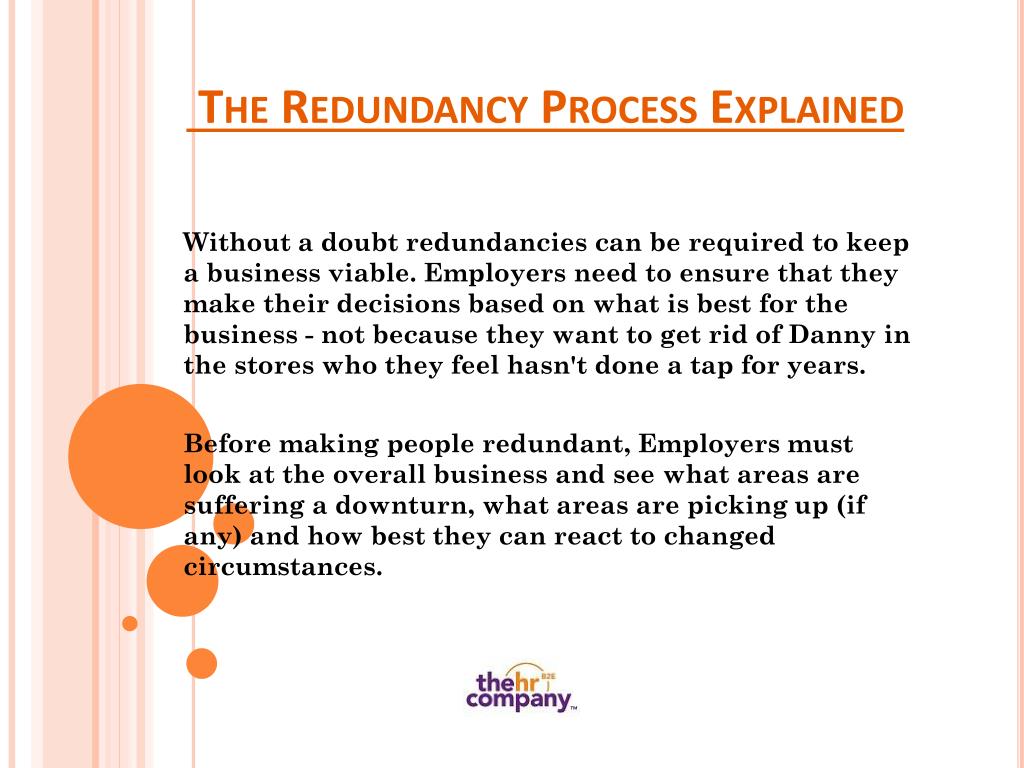Redundancy Pay If Company Goes Bust: Comprehending Your Entitlements in the UK
Redundancy Pay If Company Goes Bust: Comprehending Your Entitlements in the UK
Blog Article
Checking Out the Operational Dynamics of Firm Redundancy and Its Long-Term Sustainability

Redundancy Methods for Service Continuity
In order to guarantee undisturbed operations, organizations must execute reliable redundancy methods for business connection. Redundancy in this context describes the replication of essential parts or functions within a system to minimize the impact of potential failures. By integrating redundancy approaches, organizations can boost their resilience against interruptions triggered by numerous factors such as natural disasters, devices failures, or cyber-attacks.
One typical redundancy approach is the execution of back-up systems and information storage space solutions. This involves creating duplicates of necessary information and systems that can be turned on in case of a primary system failure. Additionally, organizations can establish repetitive interaction channels and power sources to preserve connectivity and operations during unpredicted events.
Furthermore, cross-training workers to do numerous duties within the firm can work as a beneficial redundancy strategy. If key employees are inaccessible due to ailment or various other factors, this ensures that necessary tasks can still be carried out also. Generally, efficient redundancy techniques are important for businesses to promote operational connection and lessen the effect of potential disturbances.
Effect of Redundancy on Business Durability
Given the critical function redundancy strategies play in ensuring service continuity, discovering the effect of redundancy on organizational strength becomes important for recognizing the alternative functional dynamics of a firm. Organizational strength refers to an entity's capacity to adjust to interruptions, recover from obstacles, and transform when needed while keeping core functions. Redundancy, when purposefully implemented, can dramatically contribute to improving a company's durability despite unexpected difficulties. By having back-up systems, personnel, or processes in position, companies can much better withstand shocks and continue procedures with minimal interruption.
Furthermore, redundancy can boost worker spirits and confidence, understanding that there are contingency plans in position to attend to unpredicted conditions. This complacency can lead to increased productivity and an extra favorable job setting. In addition, redundancy can cultivate advancement and imagination within a company as continue reading this workers feel empowered to take calculated risks, knowing that there is a safeguard to sustain them in instance of failing. Generally, the effect of redundancy on organizational resilience is extensive, forming the long-lasting sustainability and success of a business.
Balancing Performance and Versatility in Redundancy
Achieving a harmonious balance between functional efficiency and flexible flexibility is a pivotal difficulty in the strategic release of redundancy within organizations. Reliable operations are important for keeping efficiency and cost-effectiveness, ensuring that sources are utilized efficiently. However, too much emphasis on performance alone can result in rigidity, making it hard for companies to adapt to unpredicted adjustments or obstacles. On the various other hand, flexibility allows companies to respond nimbly to evolving scenarios, fostering advancement and resilience. Yet, way too much flexibility without a strong functional foundation can lead to inadequacies and disparity.
To balance effectiveness and adaptability in redundancy planning, organizations must carefully assess their functional needs, market dynamics, and critical goals. Carrying out lean techniques can enhance effectiveness by enhancing procedures and getting rid of waste, while fostering a culture of versatility and continual renovation can improve versatility. Furthermore, purchasing cross-training programs and robust communication networks can aid grow a flexible workforce efficient in taking care of varied jobs during periods of change. Eventually, discovering the best equilibrium in between effectiveness and versatility is vital for developing a resistant and sustainable organization despite uncertainty.
Long-Term Sustainability Via Redundancy Planning
To make sure long-lasting stability and security, companies must purposefully align their redundancy preparation with long-term sustainability objectives, consequently integrating operational efficiency with adaptive versatility. Business should watch redundancy not as a reactive option to immediate troubles however as an aggressive technique for long-term success.

Proactive Measures for Lasting Business Operations
Exactly how can firms proactively boost their functional sustainability for long-term you can try this out success? Implementing positive measures is essential for firms aiming to ensure sustainable procedures.
In addition, fostering a culture of continual enhancement and discovering within the organization can boost versatility to altering market problems and client demands. Urging staff member involvement in decision-making processes and offering chances for professional growth can boost morale, efficiency, and overall efficiency. Developing clear goals, monitoring crucial performance indicators, and on a regular basis reviewing progression are crucial elements of positive sustainability administration.
Teaming up with providers, customers, and other stakeholders to promote sustainable methods throughout the supply chain can produce a ripple result of favorable effect - redundancy pay if company goes bust. By taking proactive steps towards operational sustainability, business can construct strength, drive technology, and protect their long-lasting success in an ever-evolving service landscape
Verdict

In the world of business management, the strategic implementation of company redundancy stands as an essential yet elaborate method that demands a delicate balance between operational effectiveness and long-term viability. By studying the look at this now operational dynamics that underpin business redundancy and evaluating its wider ramifications for business resilience and versatility, a nuanced understanding of just how redundancy strategies can form the future trajectory of a firm begins to unravel.Given the critical function redundancy strategies play in guaranteeing service continuity, exploring the influence of redundancy on organizational strength comes to be critical for understanding the alternative functional dynamics of a business. Overall, the effect of redundancy on business durability is extensive, shaping the long-term sustainability and success of a business.
In verdict, comprehending the functional dynamics of business redundancy is vital for making certain long-term sustainability.
Report this page